
Snapdragons and Red Giant mustard. Photo courtesy National Garden Bureau
This time of year, mums tempt us with their colorful blossoms that promise to extend the season a few more weeks. But there are other flowering plants that color the landscape this time of year, including easy-to-grow annuals that can also be found in some garden centers. Here are a few.
Snapdragons love the cooler temperatures of fall and have been known to keep blooming into December. Snaps (Antirrhinum majus) come in all sizes and colors and do best in full sun, but tolerate part sun. Even this time of year, you can sow seeds directly in soil in window boxes, pots or a patch in the landscape, according to packet instructions. Garden centers also may have snapdragons in pots. Snapdragons are great cut flowers, too.
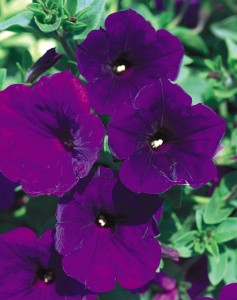
Royal Velvet petunia.
Petunias (Petunia) may already growing in your landscape or pots. Cut them back a bit, give them a dose of fertilizer, keep them watered and they will keep blooming for several more weeks. Petunias are quite tolerant of cooler temperatures.
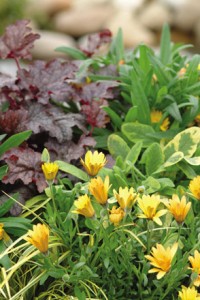
Lemon Symphony osterspermum, heuchera and variegated sage. Photo courtesy Proven Winners
Cape daisy (Osteospermum) also should revive as temperatures cool. These plants are stunning in spring and fall, but seem to lose their zip in summer when the temeratures get hot, especially at night. Indiana’s hot weather prevents the plants from resting at night, which diminishes their blooms.
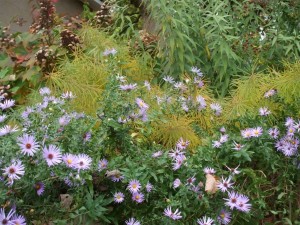
Aster mixes with Arkansas bluestar and oakleaf hydrangea for color well into fall. (C) Jo Ellen Meyers Sharp
Late-blooming perennials also carry the garden well into fall. Here’s a sampler:
Asters (Symphyotrichum) are sold this time of year along with mums. Most of them are hybrids of native asters and should be handled like mums: full sun to light shade and well-drained soil. Don’t cut back until spring, which is the best time to divide and transplants mums and asters.
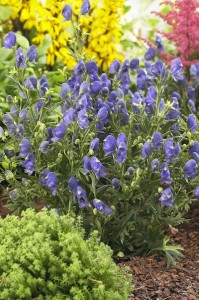
Blue Lagoon monk's hood (Aconitum). Photo courtesy PerennialResource.com
Monk’s hood (Aconitum) is a glorious, tall, late blooming perennial whose poison is the subject of many mystery novels. It does well in full sun to part shade and can be used as a cut flower.
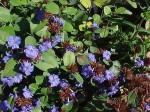
Leadwort.
Leadwort or hardy blue plumbago (Ceratostigma plumbaginoides) is a star in the fall garden with a tri-color scheme. This low-growing ground cover, which does well in sun to shade, sports beautiful blue blooms about the size of a quarter in August and September. The flowers mingle with green foliage that is turning reddish purple as fall progresses.
This plant is slow to break dormancy in spring. It makes a good companion for tulips, daffodils and other spring bulbs because as it leafs out, it camouflages their fading foliage.